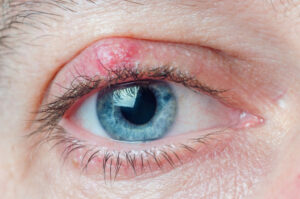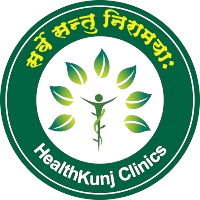Chalazion
- Symptoms, Causes, Prevention & Homeopathic treatment

What is Chalazion?
A chalazion is a common eyelid condition characterized by a blocked meibomian gland, leading to a localized, non-infectious inflammation in the eyelid. Unlike a stye (hordeolum), which is caused by an infection of the gland, a chalazion typically results from a blockage rather than an infection. It often appears as a small, painless lump on the eyelid and can vary in size from a tiny bump to a large swelling.
Symptoms
The symptoms of a chalazion can include:
- Lump on the Eyelid: A small, firm, painless bump on the upper or lower eyelid.
- Swelling: Mild to moderate swelling around the affected area.
- Redness: Redness and irritation may occur around the bump.
- Tenderness: Occasionally, the area around the chalazion can become tender.
- Visual Disturbance: Large chalazions may press against the eye, causing blurred vision or discomfort.
- Tearing: Increased tearing or watery eyes can occur.
When to See a Doctor
You should consult a healthcare provider if you experience:
- Persistent Lump: A lump on the eyelid that does not improve with at-home treatments.
- Pain or Discomfort: Increasing pain, tenderness, or swelling.
- Vision Changes: Any changes in vision or persistent irritation affecting daily activities.
- Repeated Occurrences: Frequent or recurring chalazions.
- Symptoms Worsen: Any worsening symptoms or signs of infection, such as increased redness, warmth, or discharge.
Causes
A chalazion develops when the meibomian gland, responsible for producing the oily layer of tears, becomes blocked. The primary causes include:
- Gland Blockage: The gland becomes blocked by hardened oil or sebum.
- Inflammation: Chronic inflammation of the meibomian glands.
- Poor Eyelid Hygiene: Lack of proper eyelid hygiene can contribute to gland blockages.
- Skin Conditions: Conditions like blepharitis or rosacea can increase the risk of chalazions.
Risk Factors
Several factors can increase the likelihood of developing a chalazion:
- Previous Chalazions: History of previous chalazions or other eyelid conditions.
- Skin Conditions: Chronic skin conditions such as blepharitis or rosacea.
- Eyelid Trauma: Trauma or injury to the eyelid.
- Poor Hygiene: Inadequate eyelid hygiene or frequent touching of the eyes.
- Seborrheic Dermatitis: A skin condition that can affect the eyelids and contribute to gland blockages.
Complications
Complications of a chalazion are generally rare but can include:
- Secondary Infection: Although chalazions themselves are not infectious, secondary bacterial infections can occur.
- Vision Issues: Large chalazions may press on the eye, causing vision problems or discomfort.
- Chronic Swelling: Persistent swelling or formation of multiple chalazions.
- Scar Formation: Rarely, a chalazion can lead to scarring or changes in the eyelid structure.
Preventions
Preventing chalazions involves maintaining good eyelid hygiene and addressing risk factors:
- Regular Eyelid Hygiene: Clean eyelids daily with warm water or eyelid wipes to prevent gland blockages.
- Avoid Touching Eyes: Minimize touching or rubbing the eyes to reduce the risk of introducing bacteria.
- Manage Skin Conditions: Treat underlying skin conditions such as blepharitis or seborrheic dermatitis.
- Avoid Sharing Towels: Use personal towels and avoid sharing to prevent the spread of bacteria.
Can Homeopathy Help?
Homeopathy stands out for chalazion treatment due to the following reasons:
- Surgery-Free Healing: Homeopathy offers a non-surgical solution for chalazion.
- Safety: It is a 100% safe and harmless treatment option.
- Natural Healing Principles: Homeopathic treatment is based on natural healing principles.
- Constitutional Approach: Chalazion formation often suggests an underlying constitutional tendency. Homeopathy addresses not only the chalazion but also the fundamental predisposition, aiming to prevent recurrence. Surgical removal does not address the root cause.
- Comprehensive Healing: Homeopathic treatment typically spans 2-5 months, ensuring thorough and lasting results.
- Addressing Sty Formation: During homeopathic treatment for chalazion, any tendency toward sty formation is also considered and addressed.
In summary, homeopathy offers an effective and holistic approach to chalazion treatment, focusing on both the immediate concern and the broader health context to promote long-term well-being.
Homeopathic Remedies for Chalazion
- Calcarea Carbonica: For chalazions that are large, hard, and slow to heal. Useful for individuals with a tendency to develop such conditions.
- Hepar Sulphuris: For chalazions that are tender, red, and inflamed. It can help reduce pain and inflammation.
- Silicea: For chalazions that are slow to resolve and for those with a tendency to develop similar conditions.
- Rhus Toxicodendron: For chalazions with associated itching and discomfort, particularly if improving with warmth.
- Staphysagria: For chalazions associated with past trauma or emotional stress.
Diagnosis
Diagnosis of a chalazion is generally straightforward and includes:
- Medical History: Discussing symptoms, duration, and any previous occurrences of chalazions.
- Physical Examination: Examining the eyelid for characteristic features of chalazion, including size, location, and tenderness.
- Eyelid Examination: Assessing for signs of other conditions such as blepharitis or infections.
- Differential Diagnosis: Rule out other possible eyelid conditions, such as styes, cysts, or tumors, which may require different treatments.
Treatments
Treatment for chalazion often involves a combination of home care and medical interventions:
Conventional Treatments
- Warm Compresses: Applying warm compresses to the affected eyelid for 10-15 minutes, several times a day, to help unblock the gland and promote drainage.
- Eyelid Hygiene: Maintaining good eyelid hygiene with gentle cleansing solutions to prevent recurrence.
- Medications: Topical antibiotics or steroid creams may be prescribed if there is secondary infection or significant inflammation.
- Incision and Drainage: In persistent or large chalazions, a minor surgical procedure may be performed to drain the gland.
Homeopathic Treatments
Homeopathic remedies can complement conventional treatments:
- Arnica Montana: For trauma-related swelling and bruising, which may accompany a chalazion.
- Graphites: For chalazions with associated thickening or crusting of the eyelid.
- Bovista: For chalazions that are slow to heal, with a feeling of heaviness in the eyelid.
- Ledum Palustre: For chalazions with a tendency to develop in cold weather or associated with coldness in the affected area.
Lifestyle and Home Remedies
Homeopathy stands out for chalazion treatment due to the following reasons:
- Surgery-Free Healing: Homeopathy offers a non-surgical solution for chalazion.
- Safety: It is a 100% safe and harmless treatment option.
- Natural Healing Principles: Homeopathic treatment is based on natural healing principles.
- Constitutional Approach: Chalazion formation often suggests an underlying constitutional tendency. Homeopathy addresses not only the chalazion but also the fundamental predisposition, aiming to prevent recurrence. Surgical removal does not address the root cause.
- Comprehensive Healing: Homeopathic treatment typically spans 2-5 months, ensuring thorough and lasting results.
- Addressing Sty Formation: During homeopathic treatment for chalazion, any tendency toward sty formation is also considered and addressed.
In summary, homeopathy offers an effective and holistic approach to chalazion treatment, focusing on both the immediate concern and the broader health context to promote long-term well-being. Incorporating lifestyle changes and home remedies can help manage and prevent chalazions:
- Warm Compresses: Regular application of warm compresses to the affected eyelid to promote drainage and reduce swelling.
- Proper Eyelid Hygiene: Gently clean the eyelids with warm water or eyelid wipes to maintain hygiene and prevent blockages.
- Healthy Diet: Include foods rich in vitamins and minerals to support overall skin health.
- Avoid Irritants: Avoid exposure to irritants or allergens that may contribute to eyelid inflammation.
Effective Health Tips For Patients Of Chalazion To Follow:
1 Wash Your Hands Often:
When suffering from chalazion, try to you keep your hands away from your face and eyes as much as you can. Usually, your hands have dust, grime, and dirt that can clog oil glands near chalazion and may irritate chalazion
2 Apply Warm Compress:
Apply a piece of warm, wet, clean cloth to your chalazion-affected eye area and hold it gently till that area cools down. Reapply the warm compress for 5 minutes thrice every day while going for chalazion treatment.
3 Practice Good Eye Hygiene And Care:
Wash your eyelids by using baby shampoo on a soft cotton swab. Make sure that you do not rub your eyes. Do not squeeze or make an attempt to pop the chalazion lump, as it increases the risk of infection, inflammation, and damage to your eyelid’s tissue.
4 Massage Your Eyelids:
Gently massage your affected eyelid, as it helps promote the draining process and quick healing. Later, apply a warm compress on your closed affected eyelid for five minutes and gently massage the area with your fingers for 3-4 minutes.
5 Eat Healthy Foods:
Include ample fresh vegetables, fruits, whole grains, and other healthy, natural foods in your regular diet while following chalazion treatment. Avoid eating fried foods.
6 Place Cucumber Slices For Relief:
Slice a fresh cucumber stored in your refrigerator, cut it into slices, and place one or two slices of cucumber on your chalazion-affected eye for 10 minutes.
7 Wash Eyes With Cold Milk:
It helps reduce the pain resulting due to chalazion and eliminates the cysts quickly and effectively. So, wash your eye daily with cold milk when following chalazion treatment
Side-Effects Of Other Treatments For Chalazion:
Even though homeopathy is completely safe and provides you long-lasting results when used to treat chalazion, other kinds of treatments can cause certain harmful effects. Find below some side effects of other chalazion treatments.
- Steroid Injections: Steroid injection for chalazion treatment comes with many side effects. It tends to lighten the surrounding skin, which can be undesirable and appear unpleasant in dark-skinned individuals.
- Antibiotic Ointments, Medicines, And Drops: Medicines, drops, and ointments make no difference to the chalazion, particularly if the contents of the chalazion cysts comprise no infections i.e. are sterile.
- Surgery: Side-effects of surgery and drainage of a chalazion may increase the risk of infection, undesirable bleeding, and eye problems.
Preparing for Your Appointment
To make the most of your appointment, consider the following:
- Symptom Record: Keep a record of your symptoms, including when they started, their progression, and any associated factors.
- Medical History: Provide detailed information about your medical history, including any previous chalazions or related conditions.
- Questions: Prepare questions about treatment options, potential side effects, and preventive measures.
- Current Medications: List any medications or supplements you are currently taking.
